A PAIR OF SIX-FOLD BYŌBU (SCREENS) DEPICTING THE HORSE STABLE
W: 360cm
Further images
-
(View a larger image of thumbnail 1
)
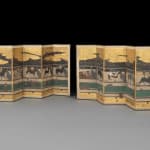
-
(View a larger image of thumbnail 2
)
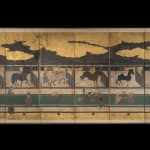
-
(View a larger image of thumbnail 3
)
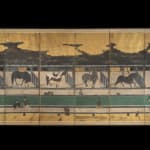
-
(View a larger image of thumbnail 4
)
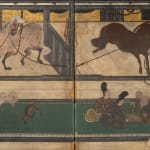
-
(View a larger image of thumbnail 5
)
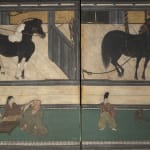
-
(View a larger image of thumbnail 6
)
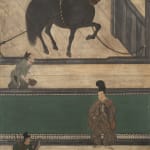
-
(View a larger image of thumbnail 7
)
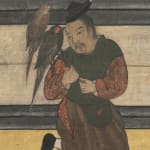
-
(View a larger image of thumbnail 8
)
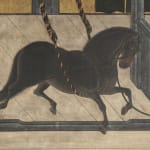
-
(View a larger image of thumbnail 9
)
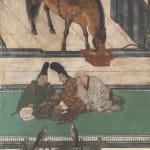
-
(View a larger image of thumbnail 10
)
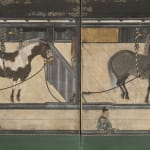
Provenance
On loan to the Art Institute of Chicago, September 1989 - September 1991
Private Collection: Europe
Exhibitions
Art Institute of Chicago, September 1989 - September 1991Literature
COMPARE:
Cleveland Museum of Art, Cleveland, Ohio, USA (1934.373), a nearly identical pair on which which the present screens were based
Tokyo National Museum, Tokyo, Japan (A-10139)
Imperial Household Agency, Tokyo, illus. Screen Paintings of the Muromachi Period: Kokka 100th Anniversary Exhibition (1989), cat. no. 35, pp. 106-7
SEE ALSO:
A pair of 17th Century screens sold Christie’s, 18 Sept 2008, USD 962,500
A pair of early 17th Century screens sold Christie’s, 28 March 2006, USD 968,000
A single late 16th early 17th Century sold Sotheby’s, 25 October 2023, GBP 482,600
‘There was a stable above wherein there was no more than five or six horses; but it was a stable only in name because it was so clean and well kept that it seemed rather to be a fine chamber for the diversion of nobles than a place to lodge horses.’ 1
Horse stables were centres of social life in Japan in this period. As places for the exhibition of fine horses - the ownership of which was crucial to the status of a samurai or feudal lord (daimyo) - they became places of reception and entertainment, of leisure and relaxation. Quite apart from their nature in the western world, they were meticulously maintained, luxuriously furnished residences. As Luis Frois (1532-97), the Portuguese Catholic missionary, also wrote in his 1585 commentary Striking Contrasts in the Customs of Europe and Japan, ‘In the homes of European nobility guests are first welcomed in the living quarters; in Japan their first reception takes place in the stables...Our stables are always behind or in the lower part of the house; in Japan, they are built at the front of the house.’2 The floors were not of earth but of sugi, a fragrant cedar used for constructing Shinto shrines, Buddhist temples and other sacred and honoured places. This was in accordance with the symbolic significance in Japanese culture of the horse itself, which by this time had been long valued for its mysterious ability to communicate with the Shinto gods and to positively affect the weather.3
The stable also enabled a proud samurai warrior class to exhibit its martial prowess, the essential importance and function of the stable, housing these horses which though not as beautiful or great in stature as their European counterparts according to western accounts, were in the words of Englishman John Saris, ‘well trust…and very full of mettle, in my opinion, farre excelling the Spanish Jennet in pride and stomacke.’4
This character is reflected in the portraits of the horses, each of which is captured with an animated life and energy. In the uppermost screen the horses are more active: one horse vigorously buckles, another rears, and a further with dappled coat moves with agitation beside a groom sweeping the stable floor; the others are poised with inquisitive postures and alert, searching expressions. The lower screen is overall more languid, though with the exception of the prancing steed: a horse bows to eat from a low trough, and at the opposite end another is curled up on a rush matt; the two central ‘strawed’ horses appear more static and, especially the skewbald horse, restful.
Fróis and Akio Okada’s accounts shed light on the differing styles of mane grooming seen on the screens: some are shown with nogami, meaning ‘field’ or ‘wild hair’, essentially the same free style of mane preferred by Europeans; others with the karihoshi or ‘shaved priest’ style, cut and tied at intervals with rice straw, worn by six of the twelve horses.5 As Richard Danford comments, this straw did not have the same humble connotations it did in Europe; it was auspicious for its association with plenty.6
Restrained by two lines leading from their bridle to stakes on the stalls, some of the muscular bodies of the horses, rendered with careful modulated linework and subtle shading, are suspended by thick ropes around their bellies (harakeke) to help support the weight of the horses as they sleep standing up.7 The animals appear essentially in profile, and with the characteristic short legs and long torso of native Japanese horses.
The screens reveal the stables to be places of social interaction and gathering, the foregrounds of each being filled with figurative depictions of informal genre activities. Relaxing on tatami mats in a raised area adjoining the stalls, samurai gentleman discuss falconry, monks and noblemen attended by pages play go, sugoroku and shogi (meaning ‘military leader’s board game’), a falconer preens two birds, and grooms can be seen working or at rest among and around the stalls. Animals too contribute to the feeling of activity: small hounds roam freely on both the ground and the tatami matting, and a pet monkey, believed to hold the power to abate equine illnesses, is also present with a young gentleman tamer. These stables scenes are significant in showing how people from different walks of life, as well as the interaction of social class, were brought together through their interest in horses and gaming.
The present screens are nearly identical to the those in the Cleveland Museum (1934.373) and were likely based on this slightly earlier pair, which date to the late Muromachi period (1392–1573). The two pairs of screens share identical stall scenes and often entire panels; differences come principally in the ordering, combination and placement of these. The groupings of the visitors are also alike, a difference being the bifurcated tatami on the Cleveland. The Cleveland screens have a band of misty cloud and gold leaf across the upper sections. Here the clouds are scalloped and applied in gold leaf, indicating the influence of later Momoyama taste for gold leaf and a showier decoration.
Another related earlier pair of screens depicting a single stable is in the Tokyo National Museum (A-10139). A further is in the Imperial Household Agency, Tokyo.8 The present screens have previously been on loan to the Art Institute of Chicago from 1989 - 91.
1 Michael Cooper, They Came to Japan: An Anthology of European Reports on Japan, 1543-1640 (Michegan, 1965), p. 135
2 Richard K. Danford et al., The First European Description of Japan, 1585: A critical English-language edition of Striking Contrasts in the Customs of Europe and Japan by Luis Frois, S. J. (London, 2014), p. 167
3 Ibid., pp. 164, 170
4 Cooper, They Came to Japan (1965), pp. 143-4
5 Danford, First European Description of Japan, 1585 (2014), p. 164; Akio Okada, trans. And ed., Yoroppa-Bunka to Nihon-Bunka [European Culture and Japanes Culture] (Tokyo, 1965)
6 Idem.
7 Ibid., p. 169
8 Screen Paintings of the Muromachi Period: Kokka 100th Anniversary Exhibition (1989), cat. no. 35, pp. 106-7









